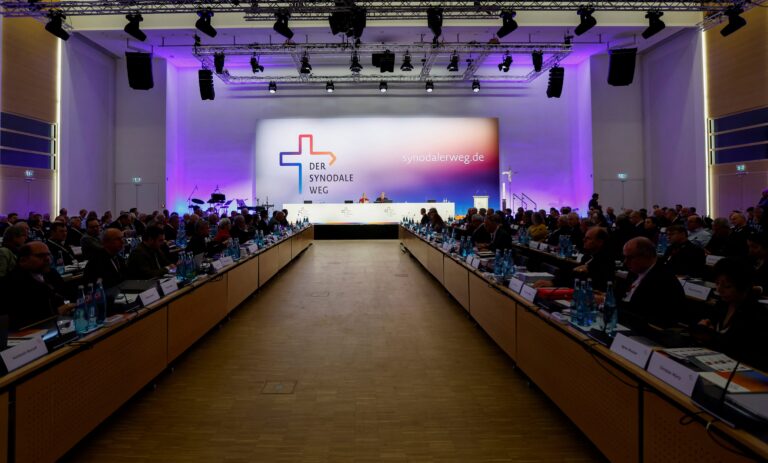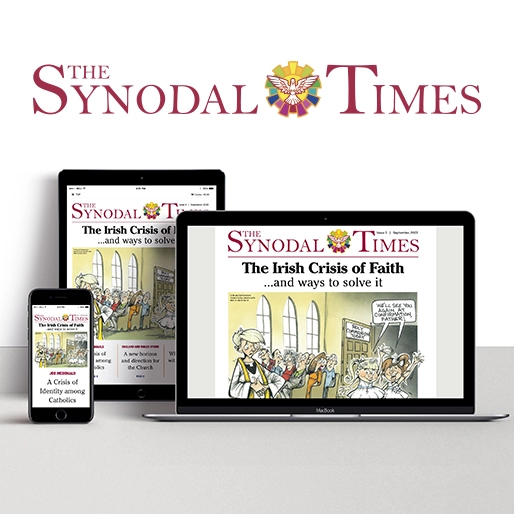In the Synodal Process we constantly hear the Holy Spirit being invoked. Often it’s when the speaker is questioned and runs out of road, they ‘spiritualise’ the rational process of Synodality– ‘well ultimately the Holy Spirit will decide’. Really? How does that work? We don’t have a mystic meg who acts as a channel, in fact we are the channel, the people of God.
The Holy Spirit has been active in the world since the beginning (Genesis 1:1) and blowing where it wills (John 3:8) not to mention its seven gifts received by all Catholics at Baptism and strengthened at Confirmation. We are given the gifts of wisdom, understanding, right judgement/prudence, courage/fortitude, knowledge, reverence and wonder/awe. That’s some arsenal of gifts to be brought to bear on any synodal meeting. So don’t add the Holy Spirit as if we need to leave a vacant chair in the room, bad theology and bad ecclesiology.
As in the Acts of the Apostles, we with the Holy Spirit in us will decide the way forward. Faith should always be on the far side of reason. And reason says that currently 1% of Catholics worldwide hold all the power in the Church, they are male and celibate and we don’t need tongues of fire to land on our heads to figure out what the Spirit is saying to that in our hearts and heads. Invert the pyramid! Even the Pope is saying it.
Reform
Ultimately, the Synodal Pathway is one way towards reform of the Church, and it is the hierarchy’s way instigated by Pope Francis and is to be welcomed. However we are being asked by the same hierarchical structure to put our faith in their ability to reform themselves, essentially those at the top of the pyramid tasked with inverting it. As the saying goes, turkeys don’t vote for Christmas.
And I understand why a priest or bishop who has been trained in a particular type of Church would have reservations handing over control to the laity. It’s a hard ask and an ever tougher sell. So by all means let’s follow the Synodal ‘yellow brick road’ to Rome and see what wizardry might or might not happen when the curtain is pulled back and the rhetoric meets reality.
I suspect many will be disappointed, but we are only beginning and this is only one path to reform. It is hard to dampen expectations that have been around since Vatican II – they are not recent phenomena invented by Pope Francis as some would like to pretend.
Thomas Sternberg, former President of the Central Committee of German Catholics who helped launch Germany’s Synodal Way (see interview in this paper) states it plainly: “I believe that we are currently experiencing a rear-guard action”. Mr Sternberg asks with incredulity: “How could the Church be so defensive about women, when women have played such an important role in the history of the Church, more than in other religions and societies?
Procedures
“How can it be that the Church is so far behind in the normality of democratic procedures, the self-evidence of co-determination and separation of powers – although these problems are by no means normatively inscribed in the Church? How can it be that gender and non-marriage as prerequisites for ordination are considered more important than the pastoral needs of the congregations? How could ecclesiastical subsidiarity in Germany be replaced more and more by diocesan administrations?”
Five bishops complained about the Synodal Way in Germany and Rome reacted negatively to the German Synodal Way. Sternberg says: “It is quite astonishing that Rome apparently listens to five individual opinions more than to 220 Synod members, including 63 bishops.
The Synodal Council is basically an extension of the Joint Conference of Laity and Bishops, which has existed for about 50 years, since the Würzburg Synod. Should it also be abolished in the future? It is also an extension of the synodal structures that we have at the level of parishes and dioceses with the pastoral councils.
“Is all this wastepaper? Without question, one thing has long been wastepaper: the idea that only ordained ministers can make decisions. This concept is no longer tenable, not least in times of catastrophic priest shortages, and it has long since ceased to be enforced in functioning councils.”
Let’s just read that again: “Without question, one thing has long been wastepaper: the idea that only ordained ministers can make decisions”. Therefore it is important to shape the reform and not allow ourselves be passive observers. Women are central to this.
Schism
“The silent schism in the Church is not about doctrine; it is about power. Essentially it is a conflict between two views of how power should be exercised in the Church. The first view is best expressed in the old slogan: Roma locuta est, causa finita est (Rome has spoken, the matter is closed). The second is found in Paul VI’s first encyclical, Ecclesiam Suam, in which he presented power as an exercise in dialogue. In summary, it is a conflict between power as dictation and power as dialogue.” (Owen O’Sullivan, The Furrow, 1994)
Rationalised
The heart of the matter is the fear of losing power; this fear is rationalised and justified in terms of a theology of authority, of 1% ruling over 1 billion in an antiquated monarchical theocracy. One of Pope Francis’s stated aims was to rid the Church of its monarchical trappings: “As people of all sorts in the Church were more and more alienated by the renewed authoritarianism of the Vatican, and its refusal to listen to them, they began finding their own solutions. Without revolt, without officially leaving the Church [Germany is an exception where they have officially left and continue to leave in their hundreds of thousands], and generally without rancour or bitterness they are looking elsewhere to find their way. With others, Catholic, Protestant, and unbelievers too, they are engaged in a dialogue to give their life direction, meaning, and purpose. They have learned that the Vatican is not the Church, and the Church is not the Kingdom, but God and conscience have priority.” (Ibid).
So what then, what is the way forward if the Synodal Path is not enough? The way forward lies in the exercise of power as dialogue and the firm renunciation of power as dictation. ‘Dialogue should be as universal as we can make it’, wrote Paul VI, adding that people, whether religious or not, are enabled by their secular education to think and to speak and to conduct a dialogue with dignity.
He asked for a dialogue characterised by charity, meekness, trust and prudence. Dialogue This is the dialogue that has been going on in Germany which the Vatican want to label as schism. Fake news when the real silent schism is the exodus of Catholics from their Church, an exodus not see We’ve had listening, now we need dialogue, that’s where the rubber hits the road.
The priesthood of the people has been ordained by God and is ready to take on its role, to step up and minister. The clerical priesthood has its role to play as older brothers and it’s difficult not to be concerned about how priests today are being run ragged in keeping an outdated model of Church on the road.
We need to stop the organ grinder, and start the handover of power to an informed and educated laity, steeped in the Holy Spirit from baptism. “Why rock the boat? Because it’s stuck in the mud. When the barque of Peter is rocked hard enough and often enough, it can be loosened from the mud to float on the high seas of freedom.” (The Furrow 1994, Owen O’Sullivan before he was silenced by the Vatican, extracts reproduced with kind permission).



